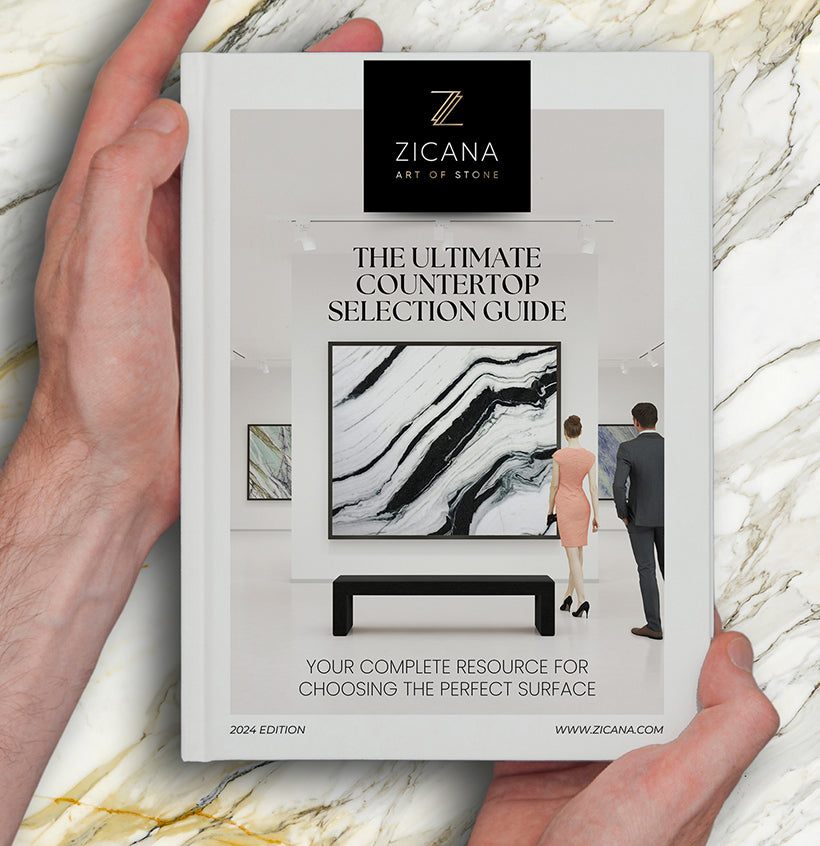Taj Mahal Quartzite vs Travertine: Comparing Two Luxe Stone Staples
In the world of high-end surface materials, few names resonate with timeless elegance like Taj Mahal Quartzite and Travertine. Whether you're a discerning homeowner tackling a luxury remodel or a design professional seeking the perfect finish for a premium build, understanding the key differences and unique advantages of these two natural stones is essential. Both are exceptional in their own right but serve very different design aesthetics, installation contexts, and functional demands.
Let’s explore the beauty, durability, maintenance, and design potential behind Taj Mahal Quartzite vs Travertine—two striking choices from the world’s finest natural materials curated at Zicana Boutique.
What Is Taj Mahal Quartzite?
Named after the iconic Indian mausoleum, Taj Mahal Quartzite isn't just about beauty—it's about performance. Quarried primarily in Brazil, this luxurious natural quartzite features soft veining on a creamy beige or off-white background, evoking subtle warmth and sophistication without overwhelming a space. This stone is often chosen as an alternative to marble, offering a similar look with markedly improved hardness and durability.
Highly dense and resistant to scratching, etching, and heat, Taj Mahal Quartzite is a top-tier option for kitchen countertops, wall applications, and bathroom vanities. Its neutral palette makes it an ideal stone for modern, transitional, or traditional interiors where understated elegance is key.
For those looking to explore this refined quartzite further, browse the full Quartzite Slabs Collection featuring exclusive options like Taj Mahal and other high-grade varieties.
Travertine: Earthy Elegance with Historic Roots
Travertine is a sedimentary natural stone formed by mineral deposits from hot springs, commonly found in Italy, Turkey, and Mexico. Visually, it embodies earthy sophistication—appearing in shades of ivory, warm beige, walnut, and gold, often with porous textures or linear striations formed by its layered geological makeup.
Used extensively in Mediterranean and classical architecture, Travertine evokes old-world charm. It’s softer and more porous than quartzite, making it excellent for floor tiles, fireplaces, and decorative wall features where texture and warmth are prioritized over hardness.
Explore Zicana’s curated Travertine Slabs Collection to see the range of color grades and finishes—from honed and filled to brushed or tumbled styles—perfect for timeless interiors.
Performance: Durability and Hardness
From a practical standpoint, the difference in hardness and durability between Taj Mahal Quartzite vs Travertine is one of the most significant. Quartzite is significantly harder on the Mohs scale, comparable to granite, and resistant to scratches, stains, and high temperatures—qualities that make it ideal for busy kitchens and bathrooms.
Meanwhile, Travertine, while beautiful, is more susceptible to etching and moisture absorption due to its porous nature. However, with proper sealing and regular maintenance, Travertine can last for decades, particularly in lower-traffic zones or decorative applications.
Aesthetic Versatility and Design Use
Choosing between Taj Mahal Quartzite and Travertine often comes down to style vision. If your interior leans toward minimalist glamour or transitional elegance, Taj Mahal Quartzite pairs seamlessly with polished cabinetry, metallic fixtures, and subdued palettes. It shines in large-format applications like full-height kitchen backsplashes and luxurious waterfall islands.
Alternatively, Travertine is a go-to for organic, rustic, or Tuscan-inspired interiors. It's commonly used for flooring with a matte finish, fireplace surrounds, and shower walls. The stone’s unique natural pits and voids can be left unfilled or filled and honed, depending on whether you prefer a more polished or raw look.
Installation Considerations and Maintenance
Quartzite, while dense and durable, is heavy and requires diamond-blade fabrication tools. Professional installation is a must—especially when customizing countertops and vertical slab applications. It’s low maintenance, only requiring occasional sealing and daily cleaning with non-acidic cleansers.
Travertine, on the other hand, is easier to work with but needs higher maintenance. Sealing every six to twelve months is advised to prevent moisture intrusion and staining. Its porous surface also means it’s better suited to dry or indoor areas unless treated with advanced sealants.
For custom projects, Zicana offers Made-to-Measure Custom Countertops crafted by leading stone fabricators, ensuring a flawless finish aligned with your client's exact vision.
Cost & Luxury Value
When comparing Taj Mahal Quartzite vs Travertine from a price perspective, quartzite usually commands a higher price tag due to its rarity, durability, and difficulty in processing. It is considered a luxury investment that adds significant resale value to your home or commercial space.
Travertine offers an accessible entry point to natural stone charm without compromising on style. It’s typically more affordable but will require more ongoing care, balancing initial savings with long-term maintenance costs.
If you're planning a premium project, now is the perfect time to explore Exclusive Offers Collection or Use Promo Code WELCOME100 for $100 off any order over $1,000 for even greater value.
FAQs: Taj Mahal Quartzite vs Travertine
Is Taj Mahal Quartzite more durable than Travertine?
Yes. Taj Mahal Quartzite is significantly harder and less porous than Travertine, making it better suited for kitchen countertops and high-use areas. It’s resistant to scratches, stains, and heat, making it a favorite in luxury performance surfaces.
Can Travertine be used in kitchens?
While Travertine can be used in kitchens, it’s typically better for low-traffic zones like backsplashes or accent walls due to its porous nature. If used as a countertop, it must be regularly sealed to resist stains and moisture.
What’s the style difference between Taj Mahal Quartzite and Travertine?
Quartzite like Taj Mahal offers a sleek, sophisticated look ideal for modern and transitional spaces, while Travertine evokes rustic warmth and classical elegance perfect for Mediterranean and Tuscan designs.
Do both materials need sealing?
Yes, but with different frequencies. Taj Mahal Quartzite should be sealed occasionally to maintain its resistance to staining. Travertine, being more porous, needs sealing more frequently—every 6 to 12 months, depending on usage.
Start Your Luxury Stone Project with Zicana Boutique
Both Taj Mahal Quartzite and Travertine bring their own narrative of luxury, performance, and timeless appeal. Whether you gravitate toward the creamy elegance of quartzite or the earthy, timeworn charm of travertine, finding the perfect stone starts with expert curation and exclusive access.
Explore the complete Quartzite Slabs Collection and Travertine Slabs Collection at Zicana Boutique—your ultimate destination for luxury stone design. Don’t forget to check our Exclusive Offers and Use Promo Code WELCOME100 for $100 off any order over $1,000.



















